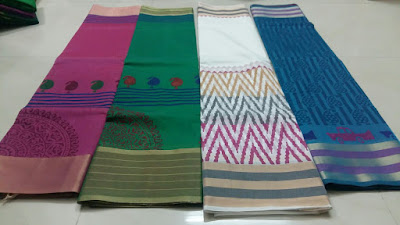It is no wrong to say that Rajasthan is blessed with Chhipa caste that is truly engaged in block printing. Further, this centuries-old tradition is still very much in trend, despite the accessibility of contemporary techniques such as screen-printing .The Block Print Fabric Sanganer is one of the examples of their great work. This stable caste has the tradition to pass their craft skills from one generation to another, thus the expertise remains within the family.
Since the beauty of block technique greatly depends on water sources, the commercial activities takes place near water availability like Sanganer, Akola, Bagru, Jodhpur, etc. Each of these centres for block printing has developed its unique design techniques over the years. When it comes to the distinguished characteristics of Block print fabric Sanganer, it include delicate lines, and sober, low toned colours creating beautiful designs like rose, poppy, and lotus. Usually, these designs are designed against a white background.
Since the beauty of block technique greatly depends on water sources, the commercial activities takes place near water availability like Sanganer, Akola, Bagru, Jodhpur, etc. Each of these centres for block printing has developed its unique design techniques over the years. When it comes to the distinguished characteristics of Block print fabric Sanganer, it include delicate lines, and sober, low toned colours creating beautiful designs like rose, poppy, and lotus. Usually, these designs are designed against a white background.
The dyes used for dying Sanganeri fabrics are typically natural colours made out of vegetables that also emit pleasant odour. Calico made sarees, bed covers, and quilts are popular from Sanganer. In this technique, the outlines are designed first and then the colour is filled i-n. Colourful, bold patterns printed repeatedly in diagonal rows. Another famous style from this region is Doo Rookhi in which artists design on both sides of the fabric. These block designs are famous for their delicate floral sprigs. Intricate detailing and fine lines are the specialties of the Sanganeri style.
A Glimpse of Sanganer Craft
A Glimpse of Sanganer Craft
Situated near jaipur, the village Sanganer has been a major centre for fine block-cutting and printing. This style is nearly 500 years' old and gained high popularity in the 16th and 17th centuries in India as well as many European countries. The famous Calico prints made Sanganer one of the major exports of the East India Company.
Its block printed textiles and handmade paper are also renowned worldwide. Moreover, it is also in the excursion route for tourist. Currently, over 315 different sized Sanganeri Printing centres are operating in this region. Estimations also reveal that nearly 25% population of this area is directly or indirectly reliant on this Industry for their livelihood.
Motifs
The elaborated work in Sanganeri block printing demands expertise in cutting mirror image blocks to create asymmetrical Mughal style designs. As mentioned earlier, this region is reckoned for producing fine block dessigned textiles on pastel or white backgrounds. However, a wide range of textiles today are printed on both dark and pale backgrounds.
The saree designs of this region are inspired from the strong Mughal aesthetics. Often the fields are covered with repeated design varying from small simple dots or geometric shape to large complex kalga and buta. Borders comprise of repeated bands of undulated twines of different sizes.
Other than these, various geometrical and God figures are also included in these motifs. You might also find folk designs. Subtlety in curves and flowers-petal designs are the prime specialties of Sanganer prints. Blocks used for producing fabrics are usually made of 'teak' or 'seesum'. These blocks are dipped in colours and printed on the cloth by means of a relief covered block. The blocks used in India are usually 23-30 cm square in size.
Typically, a motif is a combination of shapes of buds, flower, and leaves, keri (mango), katar (dagger), jhumka (ear-ring) or even pan (betel leaf). The interesting fact here is that animal shapes are never used on these fabrics, especially which are meant for costumes. This design is visible from small flower motifs such as roses, stylized sunflowers, narcissuses, and other flowers like daturas, arkas, and rudrakshas. On Sanganeri fabric, also called ‘chintz’ yellow, and green blue with different hues are used as the background.

No comments:
Post a Comment